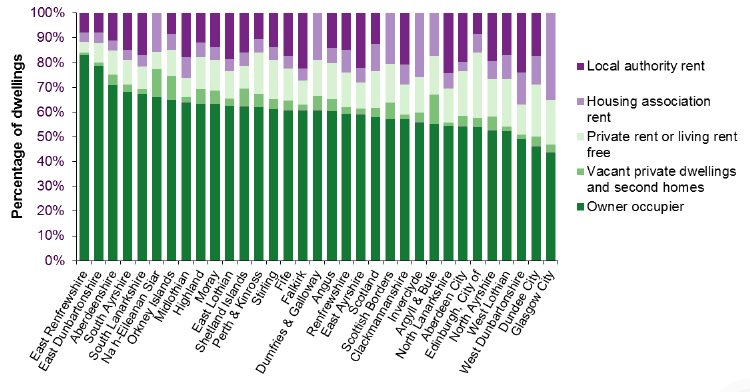Housing statistics 2017: key trends summary
Annual statistical report, covering up to 31 March 2017, on total new housing supply in Scotland across all sectors.
This document is part of a collection
Stock by Tenure
In 1981, less than 40% of dwelling stock (0.72 million dwellings) was owner occupied. By 2000 this had risen to 63% (1.47 million) although the proportion has fallen again in the last few years so that, in 2015, 58% (1.48 million) of dwelling stock was owner occupied.
The statistics presented in this section are based on March 2015 because this is the latest available Scottish Household Survey ( SHS) dataset at the time of this publication. Updated stock by tenure figures for the year 2016 will be published on our web pages alongside this document, when the SHS 2016 is available in late September 2017.
The number of dwellings in Scotland has increased by 551,000 in the last 3 decades from 1.97 million in 1981 to 2.55 million in 2015. This has coincided with an increasing Scottish population and the increased prevalence of smaller households [2] .
During this period there have been significant changes in housing tenure. In 1981, less than 40% of dwelling stock (0.72 million dwellings) was owner occupied. By 2000, the number had more than doubled to 1.47 million and accounted for 63% of dwelling stock. In the last 6 years owner occupied stock has fallen from 62% (1.52 million) in 2008 to 58% (1.48 million) in 2015.
Two factors have contributed to the shift toward owner occupation: the introduction of the right to buy for public authority tenants in 1979 coupled with the decline of local authority new build, and the increased contribution of private sector house building. Chart 6a illustrates the changes in the size of private rented sector stock, compared with councils and housing associations over the 15 year period from 2001 to 2015.
Chart 6a: Numbers of stock by private rented, council housing, and housing associations, 2001 to 2015

The recent reduction in owner occupation has coincided with an increase in the number renting privately or living rent free from 10% (around 248,000 dwellings) in 2008 to 15% (around 382,000 dwellings) in 2015, as shown in Chart 6b. This may have been partly caused by the economic downturn and the difficulty potential home owners have subsequently experienced in securing a mortgage.
Chart 6b: Estimated stock of dwellings by tenure, 1981 to 2015

Note the change in methodology from March 2001. Scottish Household Survey data is combined with dwelling counts of occupied and vacant property (National Records of Scotland data) to split privately owned stock into owner occupied, private rented and vacant. Social rented stock counts provided by local authorities and the Scottish Housing Regulator.
Local authority level tenure estimates are shown in Chart 7. The rate of owner occupation varies from 83% in East Renfrewshire to 44% in Glasgow. In general, as expected, cities have lower owner occupation rates. The proportion of dwellings rented privately ranges from 4% in East Renfrewshire to 27% in Edinburgh, with cities tending to have higher rates of households in the private rented sector. Percentages of households that are social renting range from 12% in East Renfrewshire and East Dunbartonshire to 37% in West Dunbartonshire.
Chart 7: Tenure in Scotland by local authority 2015

Link to tenure tables: http://www.gov.scot/Topics/Statistics/Browse/Housing-Regeneration/HSfS/KeyInfo
The Scottish Household Survey website presents information on housing stock by tenure. Chapter 3 on Housing contains tables on tenure of household by year and by household age group: http://www.gov.scot/Topics/Statistics/16002/PublicationAnnual
Statistics on housing stock in the other UK nations can be found through the following link to the Department for Communities and Local Government website: http://www.communities.gov.uk/housing/housingresearch/housingstatistics/housingstatisticsby/stockincludingvacants/livetables/
Contact
Email: Esther Laird, esther.laird@gov.scot
Phone: 0300 244 4000 – Central Enquiry Unit
The Scottish Government
St Andrew's House
Regent Road
Edinburgh
EH1 3DG
There is a problem
Thanks for your feedback